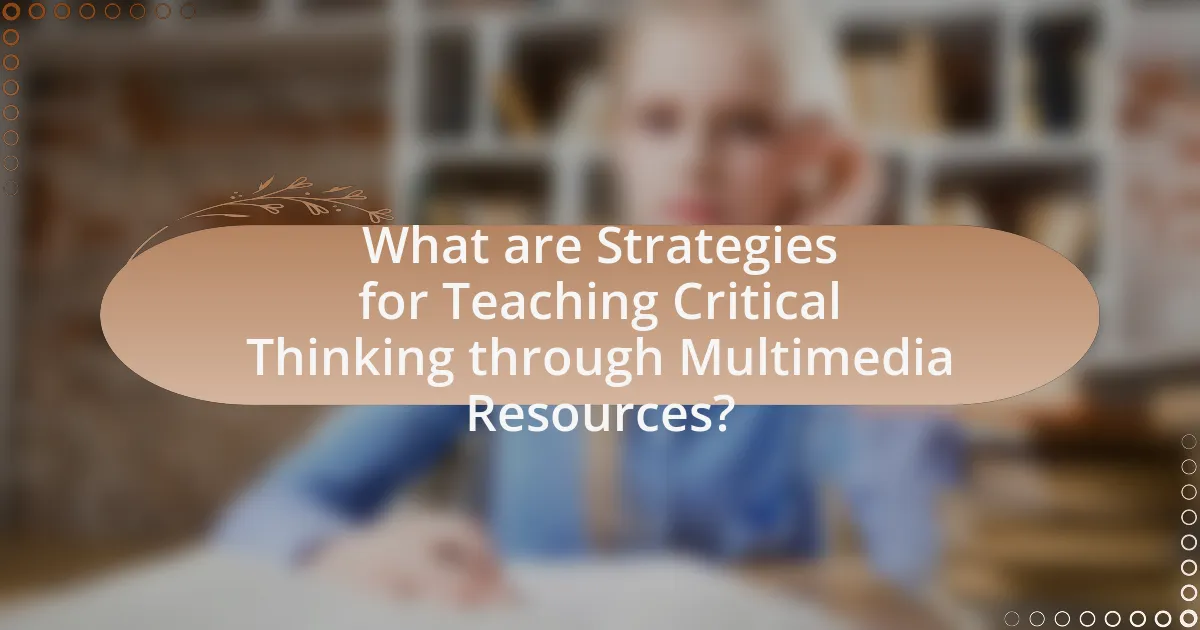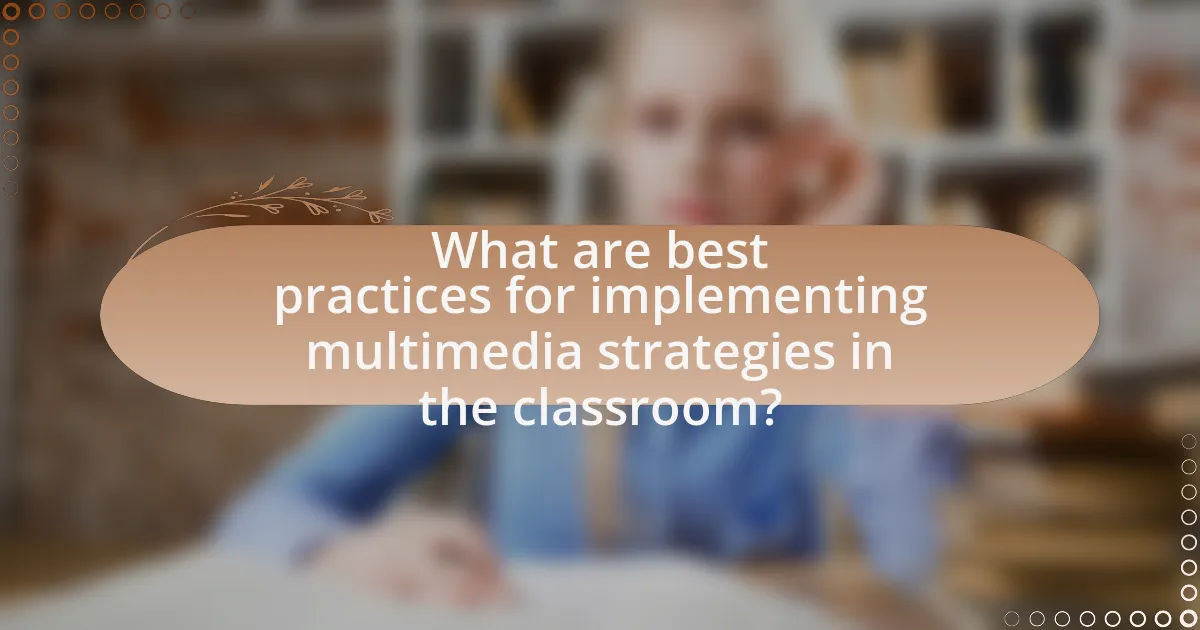The article focuses on strategies for teaching critical thinking through multimedia resources, highlighting the effectiveness of interactive simulations, video analysis, and collaborative online platforms. It discusses how these multimedia approaches enhance student engagement and critical thinking skills by providing diverse formats that stimulate analytical thinking. Key components of effective multimedia strategies, criteria for selecting appropriate resources, and the role of technology in fostering collaborative learning experiences are also examined. Additionally, the article addresses challenges in integrating technology and offers best practices for implementing multimedia strategies in the classroom to promote critical thinking development.

What are Strategies for Teaching Critical Thinking through Multimedia Resources?
Strategies for teaching critical thinking through multimedia resources include using interactive simulations, video analysis, and collaborative online platforms. Interactive simulations allow students to engage in problem-solving scenarios that require critical analysis and decision-making. Video analysis encourages learners to evaluate content critically by assessing arguments, identifying biases, and discussing perspectives. Collaborative online platforms facilitate group discussions and peer feedback, promoting diverse viewpoints and deeper understanding. Research indicates that these multimedia approaches enhance engagement and improve critical thinking skills, as evidenced by studies showing increased analytical performance in students exposed to such resources.
How can multimedia resources enhance critical thinking skills?
Multimedia resources enhance critical thinking skills by providing diverse formats that engage learners and stimulate analytical thinking. These resources, such as videos, interactive simulations, and infographics, encourage students to evaluate information from multiple perspectives, fostering deeper understanding. Research indicates that students exposed to multimedia learning environments demonstrate improved problem-solving abilities and higher-order thinking skills, as they are required to synthesize information and make connections across various content types. For instance, a study by Mayer (2009) in “The Cambridge Handbook of Multimedia Learning” shows that multimedia presentations can lead to better retention and comprehension, which are essential components of critical thinking.
What types of multimedia resources are most effective for teaching critical thinking?
Interactive simulations and video-based learning are the most effective multimedia resources for teaching critical thinking. Interactive simulations allow learners to engage in problem-solving scenarios that require analysis and decision-making, fostering critical thinking skills through experiential learning. Video-based learning, particularly when it includes real-world case studies, enhances understanding by providing visual context and prompting discussions that challenge assumptions. Research indicates that these methods significantly improve students’ ability to evaluate information and develop reasoned arguments, as evidenced by studies showing increased engagement and retention rates in courses utilizing these resources.
How do different multimedia formats impact student engagement and understanding?
Different multimedia formats significantly enhance student engagement and understanding by catering to diverse learning styles and providing interactive experiences. Research indicates that students exposed to multimedia resources, such as videos, interactive simulations, and infographics, demonstrate higher retention rates and improved comprehension compared to traditional text-based materials. For instance, a study by Mayer (2009) found that students who learned through multimedia presentations scored 50% higher on retention tests than those who learned from text alone. This effectiveness stems from the ability of multimedia to present information in varied formats, making complex concepts more accessible and engaging for learners.
Why is critical thinking important in education?
Critical thinking is important in education because it equips students with the ability to analyze information, evaluate arguments, and make reasoned decisions. This skill fosters independent thinking and enhances problem-solving capabilities, which are essential for academic success and real-world applications. Research indicates that students who engage in critical thinking perform better academically; for instance, a study published in the Journal of Educational Psychology found that critical thinking instruction significantly improved students’ performance on standardized tests. Thus, integrating critical thinking into educational curricula is vital for developing informed and capable individuals.
What skills are developed through critical thinking?
Critical thinking develops several essential skills, including analytical reasoning, problem-solving, decision-making, and effective communication. Analytical reasoning enables individuals to evaluate information critically and identify logical connections. Problem-solving skills are enhanced as critical thinkers learn to approach complex issues systematically. Decision-making skills improve through the evaluation of evidence and consideration of various perspectives. Effective communication is fostered as critical thinkers articulate their thoughts clearly and persuasively. These skills are vital in academic settings and professional environments, as they contribute to informed and rational decision-making processes.
How does critical thinking influence student success in various subjects?
Critical thinking significantly enhances student success across various subjects by fostering analytical skills, problem-solving abilities, and effective communication. Students who engage in critical thinking can evaluate information, make informed decisions, and apply knowledge in diverse contexts, leading to improved academic performance. Research indicates that students who develop critical thinking skills demonstrate higher achievement levels, as evidenced by a study published in the Journal of Educational Psychology, which found that critical thinking instruction led to a 20% increase in student performance across subjects such as mathematics, science, and language arts. This correlation underscores the importance of integrating critical thinking strategies into educational practices to promote comprehensive learning and success.

What are the key components of effective multimedia strategies?
The key components of effective multimedia strategies include clear objectives, audience analysis, content organization, and appropriate technology integration. Clear objectives ensure that the multimedia content aligns with educational goals, while audience analysis helps tailor the material to the learners’ needs and preferences. Content organization involves structuring information logically to enhance comprehension, and appropriate technology integration ensures that the chosen tools effectively support the learning experience. Research indicates that these components significantly improve engagement and retention in educational settings, as evidenced by studies showing that well-structured multimedia presentations can increase information retention by up to 50%.
How can educators select appropriate multimedia resources?
Educators can select appropriate multimedia resources by evaluating their relevance to learning objectives, assessing the quality of content, and considering the engagement level of the resources. Relevance ensures that the multimedia aligns with the specific skills or knowledge students need to develop, while quality involves checking for accuracy, credibility, and production standards. Engagement is crucial as resources that capture students’ interest can enhance motivation and facilitate deeper learning. Research indicates that multimedia resources that are interactive and visually appealing can significantly improve student engagement and retention of information, as shown in studies by Mayer (2009) on multimedia learning principles.
What criteria should be used to evaluate multimedia resources for teaching?
To evaluate multimedia resources for teaching, criteria should include educational value, engagement level, accessibility, and alignment with learning objectives. Educational value assesses the resource’s ability to enhance understanding of critical thinking concepts, while engagement level measures how well the resource captures and maintains student interest. Accessibility ensures that all students, including those with disabilities, can utilize the resource effectively. Alignment with learning objectives confirms that the resource supports the specific goals of the curriculum. These criteria are essential for selecting effective multimedia tools that foster critical thinking skills in students.
How can educators align multimedia resources with learning objectives?
Educators can align multimedia resources with learning objectives by first clearly defining the specific learning outcomes they aim to achieve. This involves identifying the skills and knowledge students should acquire, such as critical thinking, problem-solving, or analytical skills. Once the objectives are established, educators can select multimedia resources—such as videos, interactive simulations, or digital games—that directly support these goals. For instance, a study by the University of California found that using interactive simulations in science education significantly improved students’ understanding of complex concepts, demonstrating that targeted multimedia can enhance learning outcomes. By ensuring that the chosen resources are relevant and directly linked to the defined objectives, educators can effectively facilitate the desired learning experiences.
What role does technology play in teaching critical thinking?
Technology plays a crucial role in teaching critical thinking by providing interactive and engaging platforms that facilitate analysis, evaluation, and synthesis of information. Digital tools such as simulations, online discussion forums, and multimedia presentations encourage students to explore complex problems, collaborate with peers, and reflect on their reasoning processes. Research indicates that students who engage with technology-enhanced learning environments demonstrate improved critical thinking skills, as evidenced by a study published in the Journal of Educational Psychology, which found that technology integration in classrooms significantly enhances students’ ability to analyze and evaluate information critically.
How can technology facilitate collaborative learning experiences?
Technology facilitates collaborative learning experiences by providing tools that enable real-time communication, resource sharing, and interactive engagement among learners. For instance, platforms like Google Workspace and Microsoft Teams allow students to work together on projects simultaneously, regardless of their physical location. Research indicates that collaborative tools enhance student engagement and improve learning outcomes; a study published in the Journal of Educational Psychology found that students using collaborative technologies scored 20% higher on assessments compared to those who did not. Additionally, technology supports diverse learning styles through multimedia resources, fostering critical thinking and problem-solving skills in collaborative settings.
What are the challenges of integrating technology in the classroom?
The challenges of integrating technology in the classroom include inadequate training for teachers, lack of access to resources, and resistance to change from both educators and students. Inadequate training often leads to ineffective use of technology, as teachers may not feel confident in incorporating new tools into their teaching methods. According to a study by the International Society for Technology in Education, 70% of teachers reported feeling unprepared to integrate technology effectively. Additionally, lack of access to necessary resources, such as reliable internet and devices, can hinder the implementation of technology in classrooms, particularly in underfunded schools. Resistance to change can stem from a preference for traditional teaching methods, making it difficult to adopt innovative approaches that leverage technology for critical thinking development.

What are best practices for implementing multimedia strategies in the classroom?
Best practices for implementing multimedia strategies in the classroom include integrating diverse formats such as videos, podcasts, and interactive simulations to enhance engagement and understanding. Research indicates that using multimedia can improve retention rates by up to 60% compared to traditional teaching methods, as it caters to various learning styles and keeps students actively involved. Additionally, providing clear objectives and context for multimedia use ensures that students can connect the content to their learning goals, thereby fostering critical thinking skills. Regularly assessing the effectiveness of multimedia tools through student feedback and performance metrics further refines their application, ensuring that they meet educational objectives effectively.
How can educators create an interactive learning environment?
Educators can create an interactive learning environment by incorporating multimedia resources that engage students actively in the learning process. Utilizing tools such as videos, interactive simulations, and collaborative platforms fosters participation and critical thinking. Research indicates that students who engage with multimedia resources demonstrate improved retention and understanding of complex concepts, as evidenced by a study published in the Journal of Educational Psychology, which found that interactive learning environments enhance student motivation and achievement. By integrating these strategies, educators can effectively promote an engaging and dynamic classroom atmosphere.
What techniques can be used to encourage student participation with multimedia?
To encourage student participation with multimedia, educators can implement interactive elements such as quizzes, polls, and discussion forums integrated within multimedia presentations. These techniques actively engage students by prompting them to respond and share their thoughts, fostering a collaborative learning environment. Research indicates that interactive multimedia can enhance student motivation and retention; for instance, a study by Mayer (2009) found that students who engaged with interactive elements in multimedia learning environments performed better than those who did not. Additionally, incorporating storytelling and real-world applications in multimedia content can make the material more relatable, further increasing student involvement.
How can feedback be effectively integrated into multimedia lessons?
Feedback can be effectively integrated into multimedia lessons by utilizing interactive elements that allow for real-time responses and assessments. For instance, incorporating quizzes, polls, and discussion forums within multimedia content enables learners to receive immediate feedback on their understanding. Research indicates that immediate feedback can enhance learning outcomes, as it allows students to identify misconceptions and adjust their thinking promptly. A study by Hattie and Timperley (2007) highlights that feedback is most effective when it is specific, timely, and actionable, which can be achieved through multimedia tools that facilitate ongoing interaction and reflection.
What common pitfalls should educators avoid when using multimedia resources?
Educators should avoid the pitfall of overloading students with excessive multimedia content, as this can lead to cognitive overload and hinder learning. Research indicates that when learners are presented with too much information at once, their ability to process and retain knowledge diminishes (Sweller, 1988). Additionally, educators must be cautious of using multimedia that lacks relevance to the learning objectives, as irrelevant content can distract students and detract from critical thinking development. Studies show that multimedia resources should align closely with educational goals to enhance engagement and comprehension (Mayer, 2009). Lastly, neglecting to provide adequate guidance on how to critically analyze multimedia can result in superficial understanding, as students may struggle to discern credible information from unreliable sources.
How can over-reliance on technology hinder critical thinking development?
Over-reliance on technology can hinder critical thinking development by reducing individuals’ ability to analyze information independently. When people depend heavily on technology for answers, they may not engage in the cognitive processes necessary for evaluating arguments, questioning assumptions, or synthesizing information. Research indicates that frequent use of search engines and digital devices can lead to superficial processing of information, as users often skim content rather than critically assess it. A study by the Pew Research Center found that 46% of Americans feel overwhelmed by the amount of information available online, which can lead to cognitive overload and hinder deep thinking. Thus, excessive reliance on technology can diminish critical thinking skills by promoting passive consumption of information rather than active engagement and analysis.
What strategies can mitigate distractions caused by multimedia tools?
To mitigate distractions caused by multimedia tools, educators can implement structured guidelines for usage. Establishing clear rules about when and how multimedia can be used during lessons helps maintain focus. Research indicates that structured multimedia use can enhance learning outcomes by reducing cognitive overload, as shown in studies by Mayer (2009) on multimedia learning principles. Additionally, incorporating breaks between multimedia segments allows students to process information without becoming overwhelmed, which is supported by cognitive load theory. By creating a balanced approach to multimedia integration, distractions can be minimized, fostering a more effective learning environment.
What practical tips can enhance the effectiveness of multimedia resources in teaching critical thinking?
Incorporating interactive elements into multimedia resources significantly enhances their effectiveness in teaching critical thinking. Interactive features, such as quizzes, discussion forums, and simulations, engage learners actively, prompting them to analyze information and make decisions based on evidence. Research indicates that active learning strategies, which include these interactive components, can improve critical thinking skills by up to 20% (Freeman et al., 2014, “Active Learning Increases Student Performance in Science, Engineering, and Mathematics,” Proceedings of the National Academy of Sciences). Additionally, using diverse multimedia formats—such as videos, infographics, and podcasts—cater to different learning styles, making complex concepts more accessible and encouraging deeper analysis. This variety not only maintains student interest but also fosters a more comprehensive understanding of critical thinking principles.